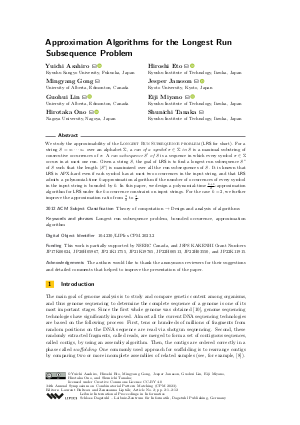@InProceedings{asahiro_et_al:LIPIcs.CPM.2023.2,
author = {Asahiro, Yuichi and Eto, Hiroshi and Gong, Mingyang and Jansson, Jesper and Lin, Guohui and Miyano, Eiji and Ono, Hirotaka and Tanaka, Shunichi},
title = {{Approximation Algorithms for the Longest Run Subsequence Problem}},
booktitle = {34th Annual Symposium on Combinatorial Pattern Matching (CPM 2023)},
pages = {2:1--2:12},
series = {Leibniz International Proceedings in Informatics (LIPIcs)},
ISBN = {978-3-95977-276-1},
ISSN = {1868-8969},
year = {2023},
volume = {259},
editor = {Bulteau, Laurent and Lipt\'{a}k, Zsuzsanna},
publisher = {Schloss Dagstuhl -- Leibniz-Zentrum f{\"u}r Informatik},
address = {Dagstuhl, Germany},
URL = {https://drops.dagstuhl.de/entities/document/10.4230/LIPIcs.CPM.2023.2},
URN = {urn:nbn:de:0030-drops-179560},
doi = {10.4230/LIPIcs.CPM.2023.2},
annote = {Keywords: Longest run subsequence problem, bounded occurrence, approximation algorithm}
}

 Creative Commons Attribution 4.0 International license
Creative Commons Attribution 4.0 International license

